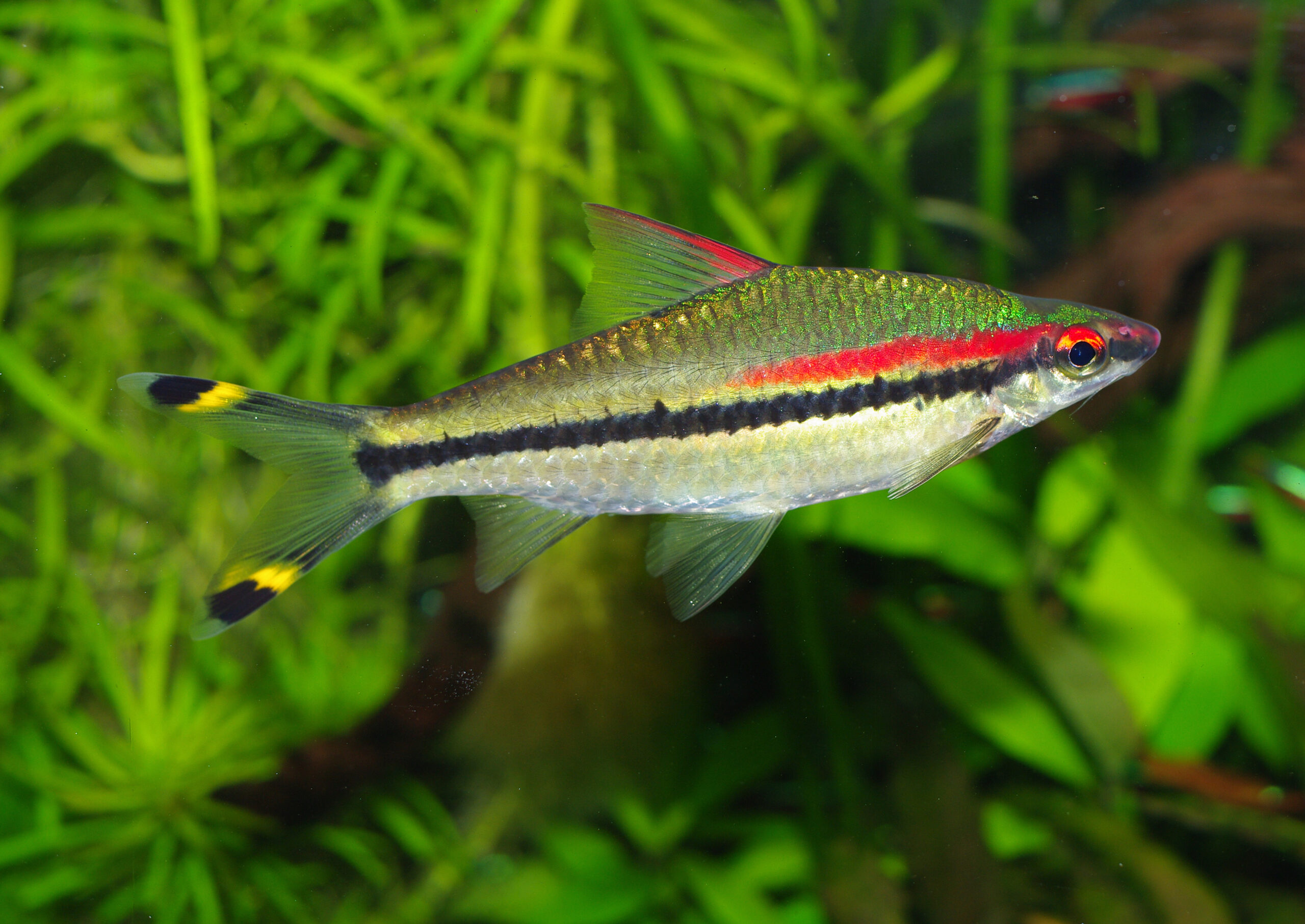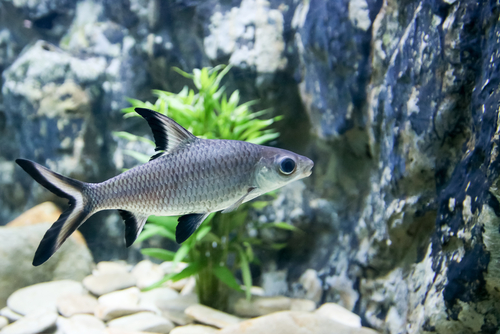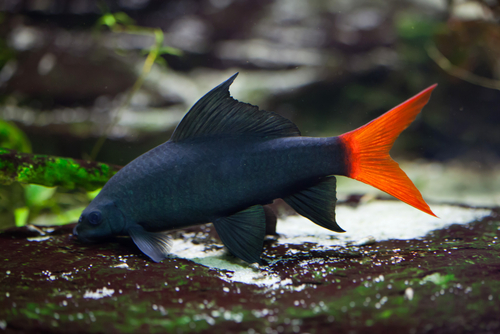When you purchase through links on our site, we may earn a commission. Here’s how it works.
Sharks hold a special place in our imagination. With their sleek, torpedo-shaped bodies and commanding dorsal fins, they have become symbols of power in the ocean. Yet not every creature with a shark-like profile is actually a shark. From freshwater catfish to schooling barbs, many unrelated fish have evolved bodies that echo the shark’s distinctive look.
This article explores more than a dozen of these “false sharks.” Some are popular in the aquarium trade, while others grow into giants that can only be found in the wild. Along the way, we will examine why many species resemble sharks and identify which ones can be kept in aquariums and which belong in their natural habitats.
Table of Contents
Why Some Fish Look Like Sharks (Convergent Evolution Explained)
Nature often arrives at the same solutions to survival challenges. This process, known as convergent evolution, describes unrelated animals developing similar features because those traits provide an advantage.
According to the U.S. Fish and Wildlife Service, convergent evolution occurs when different species face similar environmental pressures and end up developing comparable traits. In fish, this often means unrelated groups evolve similar body shapes or fin structures because those features make swimming and survival more efficient.
For fish, a streamlined body, a strong tail, and a prominent dorsal fin enable efficient swimming in open water. Sharks perfected this design over millions of years, but other groups, from catfish to rays, have independently developed shark-like silhouettes.
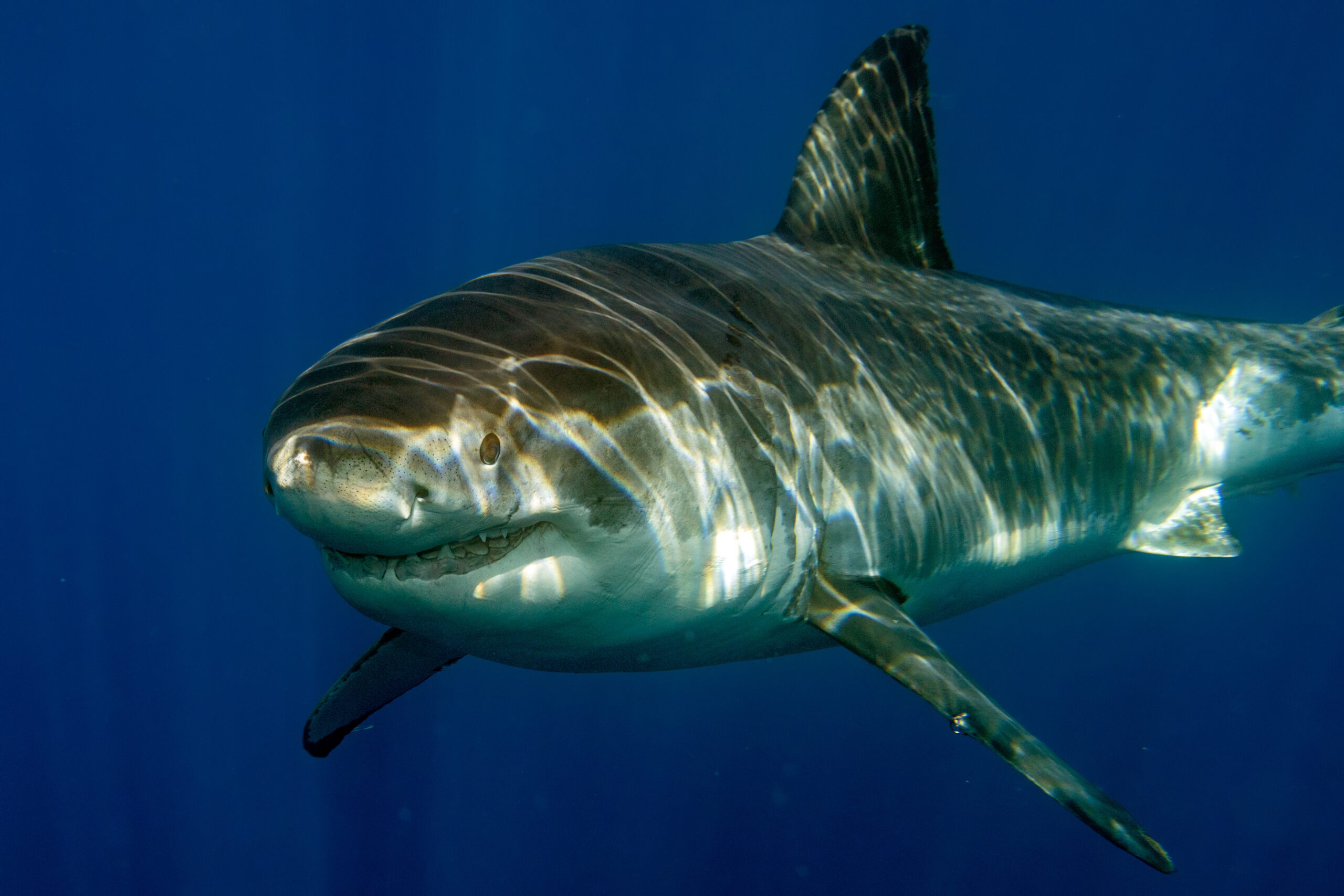
In some cases, the resemblance is striking, such as the sawfish with its sweeping dorsal fin or the bala shark, which resembles a miniature shark. In others, the similarity is more a product of aquarium trade names like “rainbow shark” or “black shark minnow,” which highlight the resemblance even when the fish is only loosely shark-like.
Which Ones Can You Keep in an Aquarium? Which Belong in the Wild?
Not all shark-like fish are suitable for home aquariums. Some remain small, colorful, and relatively peaceful, making them excellent additions to community tanks. Others grow into giants that require vast rivers or open seas.
- Good aquarium candidates: Roseline torpedo shark, rainbow shark, bicolor shark, and Siamese algae eater.
- Challenging aquarium species: Bala sharks, black shark minnows, and violet blushing sharks. These fish grow much larger than most aquarists expect and require very large tanks.
- Not aquarium-suitable: Iridescent sharks, paroon sharks, Mekong giant catfish, and sawfish. These species can reach several feet in length, are critically endangered, or require specialized brackish or marine environments.
To clarify, the species in the following sections are grouped as aquarium-friendly freshwater species, giant freshwater species that outgrow aquariums, and marine or brackish lookalikes that should be admired only in their natural habitat.
5 Freshwater Shark Lookalikes You Can Realistically Keep
These freshwater species are commonly kept in home aquariums. While some remain small and manageable, others grow surprisingly large and require specialized setups. Knowing their size, behavior, and care needs is essential before adding one to your tank.
1. Roseline Torpedo Shark (Sahyadria denisonii)
Also known as the Denison Barb, this colorful species features a torpedo-shaped body and streamlined fins that resemble those of a miniature shark. It is an active schooling fish and adds bright flashes of red and yellow to planted aquariums.
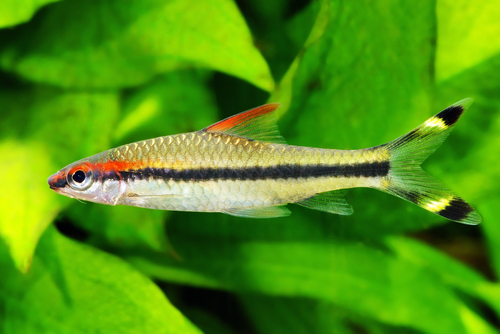
This gorgeous-looking barb is native to India but can also thrive in an aquarium. They look like sharks because of the placement of their fins and the shapes of their tails, but that’s where the equivalencies end.
A roseline torpedo shark only grows about six inches long, and they have distinct black striping with smaller red and yellow accents. Wild populations have declined sharply due to overcollection, and the species is now protected under Indian wildlife laws.
- Size: Up to 6 inches (15 cm)
- Diet: Omnivore; flakes, pellets, worms, and greens
- Temperament: Peaceful, best in groups of 6+
- Aquarium Suitability: Excellent for medium to large community tanks
- Notes: Endangered in the wild, but captive-bred specimens are available
2. Bicolor Shark (Epalzeorhynchos bicolor)
Known for its jet-black body and vivid red tail, the bicolor shark boasts a classic shark silhouette in miniature. While attractive, it can be territorial, especially toward fish with similar shapes or colors.
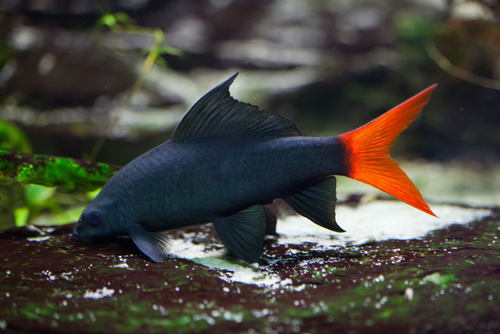
It could be said that the bicolor shark has a similar temperament to a true shark in that they can be fairly territorial when they feel they need to be. Unlike a shark, however, this fish will typically stay six inches long or under.
The bicolor shark was thought to be extinct in the wild until it was rediscovered in Thailand in the 1980s.
- Size: Up to 6 inches (15 cm)
- Diet: Omnivore; algae, vegetables, insects
- Temperament: Semi-aggressive, best kept singly
- Aquarium Suitability: Suitable for experienced aquarists
- Notes: Endangered in the wild, commonly farmed for the aquarium trade
3. Rainbow Shark (Epalzeorhynchos frenatum)
The rainbow shark is a sleek, dark-bodied freshwater fish, distinguished by its bright red fins that make it stand out in any aquarium. Its slender, torpedo-like shape and upright dorsal fin give it a distinctly shark-like profile, especially when gliding along the tank bottom.
Although small in size, it is known for being territorial and will often chase away other bottom-dwellers that enter its chosen space.
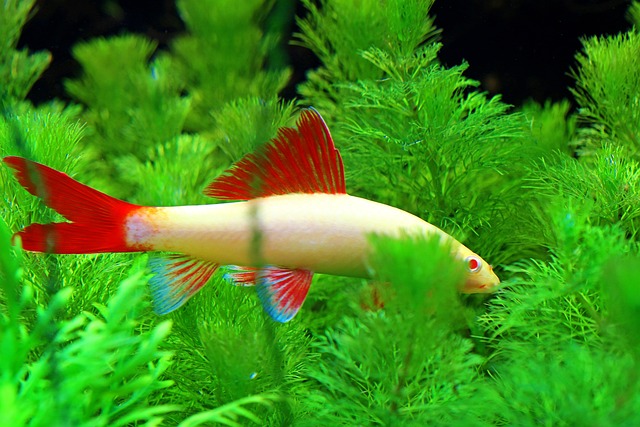
Unlike true sharks, rainbow sharks spend much of their time grazing on algae along the substrate.
- Size: Up to 6 inches (15 cm)
- Diet: Omnivore; algae, small invertebrates, prepared foods
- Temperament: Territorial, especially with bottom-dwellers
- Aquarium Suitability: Popular in aquariums, but should not be housed with its own kind
4. Silver Apollo Shark (Luciosoma setigerum)
Long, silver, and streamlined, the silver apollo shark resembles a miniature torpedo. It is a fast swimmer and jumper, making it best suited to long aquariums with secure lids. Known as expert jumpers, they can leap several feet out of the water if the tank is not covered.
They also have the dorsal fin that a shark is known for, but it’s more of a fanned fin. Most silver apollo sharks will grow to be about ten inches long.
- Size: Up to 10 inches (25 cm)
- Diet: Omnivore; prefers insects and worms
- Temperament: Peaceful schooling fish
- Aquarium Suitability: Best kept in groups in large aquariums
5. Siamese Algae Eater (Crossocheilus oblongus)
Often mistaken for other bottom feeders, the Siamese algae eater has a shark-like body shape with a distinctive dark horizontal stripe. It is valued less for its resemblance to sharks and more for its effectiveness at keeping tanks free of algae.
The Siamese algae eater is a petite fish that resembles a shark in shape, with its distinctive fins and eye placement, though it does not have a dorsal fin. Depending on how they’re swimming, they seem to be almost iridescent in their coloring, shifting from gray to gold.
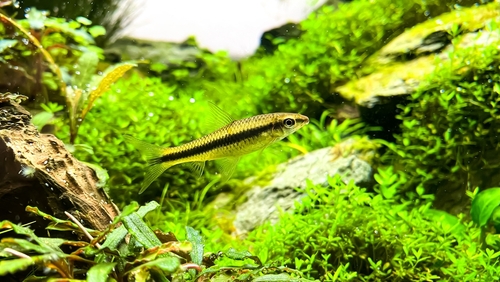
One of the few freshwater fish that will eat black beard algae, which most other algae eaters avoid. They can thrive in a carefully set up aquarium and will benefit other fish by helping to keep the aquarium clean.
- Size: Up to 6 inches (15 cm)
- Diet: Primarily algae, also detritus and plant matter
- Temperament: Peaceful
- Aquarium Suitability: Excellent algae-control fish for community tanks
4 Freshwater “Sharks” That Outgrow Most Aquariums
While some shark-like freshwater fish remain small enough to thrive in community tanks, others grow far beyond what most aquariums can handle. These species are often sold when young and appealing, but they quickly outgrow home setups and may become aggressive or stressed in confined spaces.
1. Bala Shark (Balantiocheilos melanopterus)
The bala shark resembles a true shark in miniature, with its tall dorsal fin and sleek, silvery body. Despite its peaceful nature, it grows surprisingly large and requires much more space than most aquarists anticipate.
The bala shark typically grows to be 14 inches long, making it a large fish but very small for a shark.
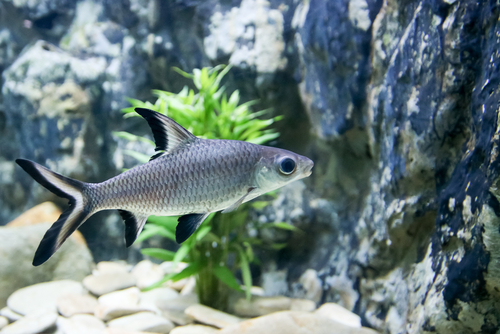
They are a fairly peaceful fish, characterized by large, beady eyes, an angled dorsal fin, and small, angled pectoral fins. They also have black accents that line their fins and tails, unlike sharks.
Despite their large size, they are naturally timid and can be startled easily by sudden movement.
- Size: Up to 14 inches (35 cm)
- Diet: Omnivore; flakes, insects, small crustaceans
- Temperament: Peaceful, best kept in groups
- Aquarium Suitability: Needs a very large tank (125+ gallons)
- Notes: Critically endangered in the wild
2. Violet Blushing Shark (Labeo boga)
The violet blushing shark gets its name from the spots of pinkish purple on its cheeks. This unusual species has pale coloring with pinkish patches near its gills, giving the appearance of “blushing.” The “blushing” effect is caused by transparent skin near the gill area, which reveals the underlying blood vessels.
While beautiful, it is uncommon in the aquarium trade and difficult to care for due to its size and demanding needs. The pink and white fish can grow up to one foot long at maturity, and as expected, have fins in similar places to a shark. Outside of this similarity, the violet blushing shark is not actually a shark.
This fish is known as a bottom feeder, so it’ll pick up scraps from other fish. They’ll also eat worms, bugs, and larvae, amongst other things. These fish are riverine, need large tanks, and high oxygen flow. They are also often mean to other fish.
- Size: Up to 12 inches (30 cm)
- Diet: Omnivore; algae, worms, insects
- Temperament: Can be aggressive toward tank mates
- Aquarium Suitability: Best left to advanced aquarists with very large tanks
3. Black Shark Minnow (Labeo chrysophekadion)
The black shark minnow is a striking, all-black fish with a prominent dorsal fin. Although it looks appealing when small, it quickly outgrows most aquariums and often becomes aggressive as it matures.
This fairly elusive fish, often referred to as the black shark, has fins that give it a shark-like appearance. These fins are much softer than a shark’s, however, having more of a fanned texture. You can also see the differences in their facial features, especially with the black shark minnow’s whiskers and beady eyes.
In the wild, they are found in fast-flowing rivers across Southeast Asia, where their size makes them dominant grazers.
- Size: Up to 24 inches (60 cm)
- Diet: Omnivore; algae, detritus, plants
- Temperament: Territorial, aggressive with age
- Aquarium Suitability: Requires an exceptionally large aquarium
4. Harlequin Shark (Labeo cyclorhynchus)
This African river fish has a distinctive body shape and a preference for feeding on algae. While only modestly shark-like, it shares the upright dorsal fin and active swimming style that earn it a place on this list. Their dorsal fin is quite thin and can be hard to see in its entirety, depending on what it’s swimming near.
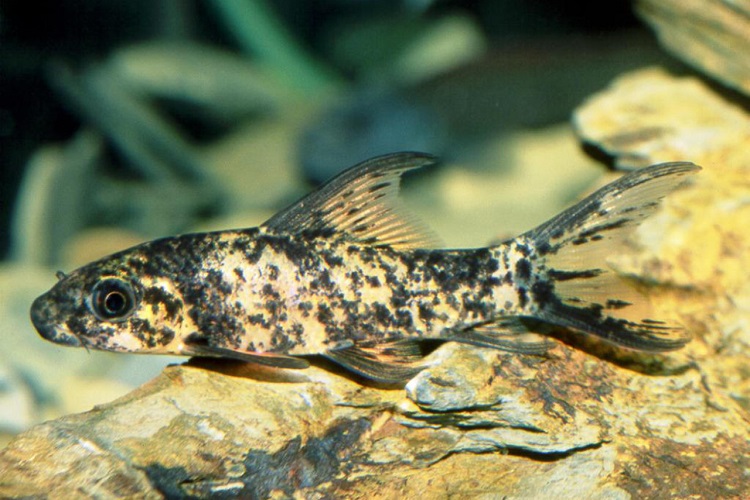
A harlequin shark bears a strong resemblance to a true shark, even though it’s a very tiny fish, comparatively. They tend to burrow themselves within as much shelter as they can find from surrounding plants and within cavernous areas. Native to the Congo River basin, they help control algae in turbulent freshwater systems.
- Size: Up to 6 inches (15 cm)
- Diet: Herbivore; algae and plant matter
- Temperament: Territorial, best kept singly
- Aquarium Suitability: Suitable for well-planted aquariums
5 Giant Freshwater Shark Lookalikes (Too Big for Tanks)
These massive catfish are often sold under “shark” trade names, but they grow far too large for home aquariums. Many of them also face serious conservation threats in the wild. While they share some features with true sharks, such as tall dorsal fins and streamlined bodies, they are river giants that are best admired in their natural habitats or in large public aquariums.
1. Iridescent Shark / Shark Catfish (Pangasianodon hypophthalmus)
Often sold under multiple names, including “Shark Catfish” or “Pangasius Catfish,” this species is one of the most commonly misrepresented aquarium fish. Juveniles are marketed as small, manageable pets, but they quickly grow into massive river giants that can exceed four feet in length.
Their smooth, silver-gray bodies and tall dorsal fins give them a shark-like appearance, but they are in fact large catfish. Its dorsal fin is closer to its head than it usually is on a shark. Much like the catfish, a shark catfish also has whiskers, or barbels, around its cheeks.
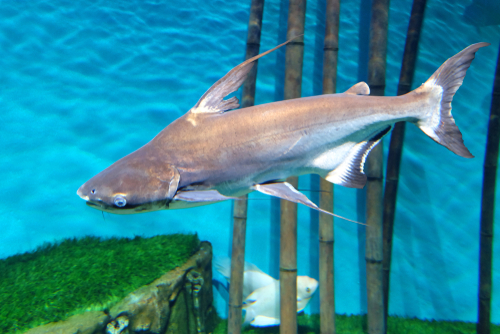
- Size: Up to 4 feet (120 cm)
- Diet: Omnivore; feeds on small fish, insects, crustaceans, and plant matter
- Temperament: Peaceful but skittish; often injures itself when startled
- Aquarium Suitability: Not suitable for home aquariums; requires thousands of gallons of space
- Notes: Widely farmed for food in Southeast Asia; commonly mis-sold in the pet trade under several “shark” names
2. Paroon Shark (Pangasius sanitwongsei)
The paroon shark is one of the largest catfish in the world, with a bulky, shark-like profile and a powerful tail. It can reach lengths of up to 10 feet in the wild, making it completely unsuitable for aquariums. With all the right fins in all the right places, they do look a lot like sharks, though their bodies tend to be more rounded than those of a typical shark.
This species is rare in the pet trade but occasionally appears misrepresented as a manageable “shark” for large tanks.
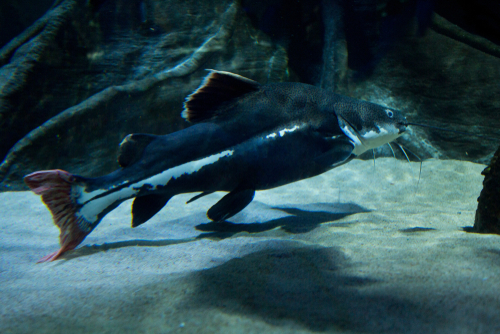
They are omnivorous scavengers and opportunistic predators, not active hunters like sharks.
- Size: Up to 10 feet (3 meters)
- Diet: Omnivore; eats fish, crustaceans, and plant matter
- Temperament: Strong and active, requires open river space
- Aquarium Suitability: Not suitable; seen only in very large public aquariums
- Notes: Sometimes confused with the iridescent shark when young
3. Mekong Giant Catfish (Pangasianodon gigas)
Among the largest freshwater fish on Earth, the Mekong giant catfish is an herbivore that can grow over nine feet long. Once common in the Mekong River, it is now critically endangered due to overfishing and habitat destruction.
The great Mekong giant catfish is similar to the shark both in size and in physicality, with the prominent, angular dorsal fin and the position of their eyes. While it shares a similar body profile with sharks, this species is far more remarkable as a freshwater giant in its own right.
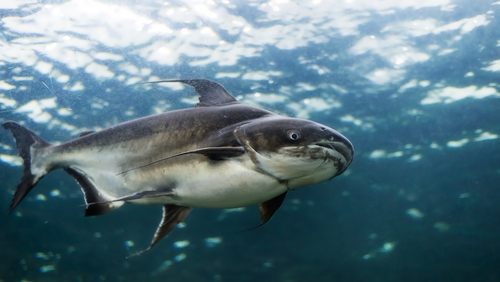
One of these phenomenal fish can reach a length of three meters. They have the same coloring as a shark does for the most part, but they don’t have sharp, scary teeth like sharks do.
- Size: Up to 9–10 feet (3 meters)
- Diet: Primarily herbivorous; algae and plant matter
- Temperament: Gentle for its size, but massive and powerful
- Aquarium Suitability: Not suitable; only kept in large conservation facilities
- Notes: Critically endangered; international efforts are underway to protect it
4. Golden Shark (Leptobarbus hoevenii)
Despite its name, the golden shark is actually a species of large barb native to Southeast Asia. Its tall dorsal fin and elongated body give it a shark-like silhouette, especially when viewed from the side. This fish’s fins are almost translucent, which is strikingly complemented by its golden-hued body.
Although sometimes sold in the aquarium trade, it grows far too large for home tanks and is better suited to large rivers or outdoor ponds.
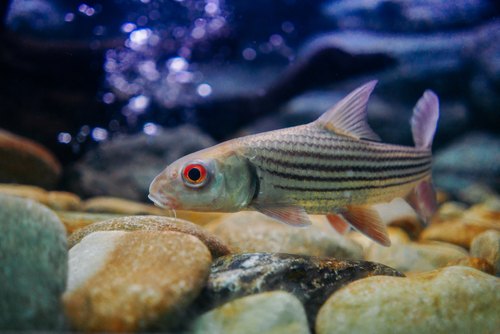
- Size: Up to 24 inches (60 cm) or more
- Diet: Omnivore; feeds on invertebrates, algae, and plant matter
- Temperament: Peaceful but active, requires plenty of swimming space
- Aquarium Suitability: Not suitable for most aquariums; requires very large systems or ponds
- Notes: Sometimes mislabeled as a true shark in the aquarium trade
5. Chinese High Fin Banded Shark (Myxocyprinus asiaticus)
This striking freshwater fish is famous for its tall dorsal fin and bold black-and-white stripes as a juvenile. Native to the Yangtze River in China, it can grow over four feet long and loses much of its dramatic juvenile pattern as it matures.
While occasionally sold for aquariums, it is unsuitable for home tanks due to its massive size and need for strong currents and cool water.
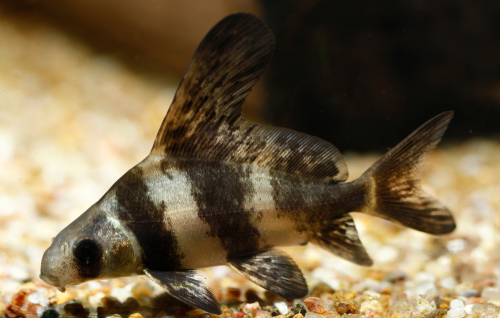
- Size: Up to 4 feet (120 cm)
- Diet: Omnivore; feeds on algae, detritus, mollusks, and worms
- Temperament: Peaceful, best in large river-like environments
- Aquarium Suitability: Not suitable; only possible in very large public aquariums or specialized ponds
- Notes: Listed as a threatened species in the wild due to habitat loss and pollution
4 Marine & Brackish Shark Lookalikes
Some of the most convincing shark lookalikes live in brackish or marine waters. While they share body shapes or fin placement with true sharks, these species are unrelated and often have unique adaptations of their own. None are suitable for home aquariums, but they remain fascinating examples of shark mimicry in the wild.
1. Columbian Shark (Ariopsis seemanni)
Also sold under names like “Silver Tipped Shark” or “Black Fin Shark,” the Columbian shark is actually a brackish-water catfish. Juveniles are often mistakenly kept in freshwater, but they require brackish and eventually full marine conditions as they mature.
Its tall dorsal fin and streamlined body give it a shark-like appearance, but improper care often leads to high mortality in captivity.
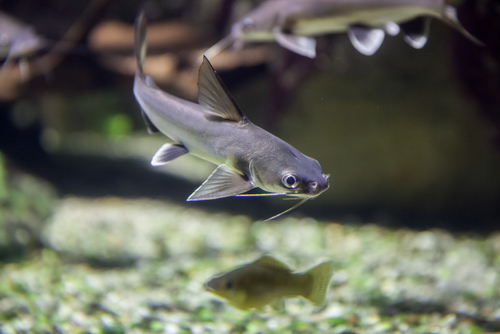
The Columbian shark is hard to ignore, given how it seems to glitter. Their dorsal fin sits a little closer to their head than a shark’s does, though the rest of their fins are positioned almost the same.
While this fish resembles a smaller version of a shark, it has distinct whiskers on its face that set it apart from a typical shark.
- Size: Up to 14 inches (35 cm)
- Diet: Omnivore; eats small fish, invertebrates, and plant material
- Temperament: Generally peaceful, best in groups
- Aquarium Suitability: Requires a transition from freshwater to brackish to marine; not recommended for beginners
- Notes: Often mis-sold as a freshwater fish, leading to poor survival rates in captivity
2. Remora (family Echeneidae)
Remoras are best known for their unusual ability to attach to larger animals such as sharks, rays, and whales. They do this using a suction disc on top of their heads, which evolved from the first dorsal fin.
While they resemble sharks in body shape and fin structure, their hitchhiking lifestyle makes them one of the most unique “false sharks.”
When they can, though, remoras prefer to use their dorsal fins to attach themselves to the bottom of a much larger fish. They will survive off of anything the large fish eat in the form of their excrement.
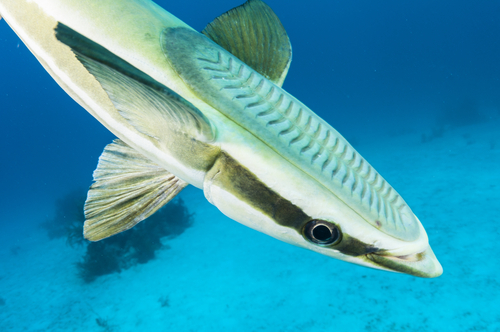
- Size: Up to 3 feet (90 cm)
- Diet: Eats parasites, scraps of food, and sometimes host waste
- Temperament: Non-aggressive, relies on host animals for transport and safety
- Aquarium Suitability: Not suitable; requires large host animals and open ocean conditions
- Notes: Their suction disc is not used to capture prey but to cling to host animals
3. Bowmouth Guitarfish (Rhina ancylostoma)
This striking species, also called the Shark Ray, combines features of both rays and sharks. From above, its tall dorsal fin and long tail resemble a shark, but its wide, flattened head and wing-like pectoral fins mark it as a ray. Unfortunately, it is critically endangered due to overfishing and habitat destruction in tropical coastal waters.
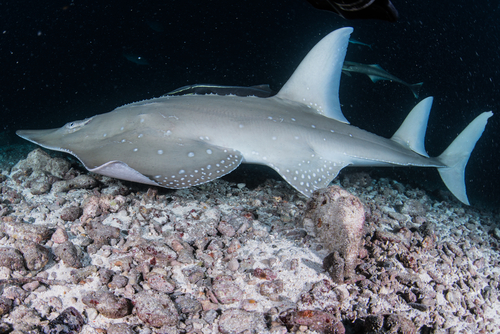
- Size: Up to 9 feet (2.7 meters)
- Diet: Carnivore; feeds on mollusks, crustaceans, and small fish
- Temperament: Slow-moving, generally docile
- Aquarium Suitability: Only found in large public aquariums
- Notes: Classified as a ray (order Rhinopristiformes), not a true shark
4. Sawfish (Pristis spp.)
Sawfish are instantly recognizable thanks to their elongated snout, or rostrum, lined with sharp teeth. Their shark-like dorsal fin and tail add to the resemblance, but they are actually rays closely related to guitarfish.
All five known species are critically endangered, making them some of the most threatened fish in the world today.
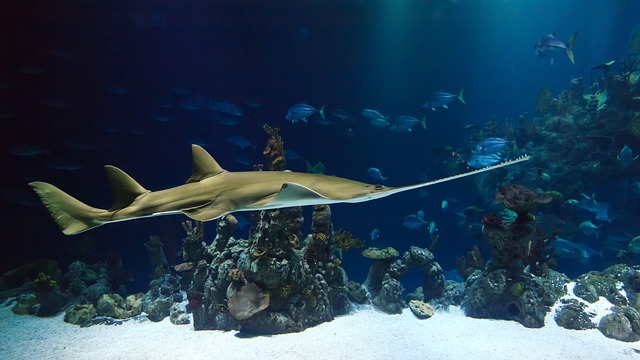
- Size: 11 to 23 feet (3.5–7 meters), depending on species
- Diet: Carnivore; uses its rostrum to slash through schools of fish before feeding
- Temperament: Powerful but not aggressive toward humans
- Aquarium Suitability: Not suitable; only kept in specialized conservation programs
- Notes: All five sawfish species are listed as critically endangered on the IUCN Red List
Shark-like fish stand out because of their bold silhouettes and unusual presence in aquariums. Their resemblance to true sharks is part of the appeal, but it is also the source of common misunderstandings. The key to enjoying these species is knowing which ones are genuinely manageable in home aquariums and which belong only in rivers, seas, or public facilities.
Which “Shark” Fish Are Best for Home Aquariums?
For aquarists, the safest choices are the smaller, hardier species that stay under a foot in length and adapt well to community tanks. The Roseline Torpedo Shark, Bicolor Shark, Rainbow Shark, Siamese Algae Eater, and Silver Apollo Shark all fit this profile. They provide the shark-like look without unmanageable growth or extreme care requirements.
Which Belong Only in the Wild
By contrast, the so-called “giant sharks,” such as the Iridescent Shark, Paroon Shark, Mekong Giant Catfish, Golden Shark, and Chinese High-Fin Banded Shark, quickly outgrow private aquariums. Marine species, including the Colombian Shark, Remora, Bowmouth Guitarfish, and Sawfish, also require specialized conditions that cannot be replicated in a home setting. These fish should be respected in their natural habitats rather than purchased for display tanks.
Tips for Choosing Responsibly
- Check the adult size and care needs of every species before purchase
- Look for captive-bred stock instead of wild-caught specimens
- Avoid species that are threatened or critically endangered
- Choose a smaller shark-like fish if you want the look without the problems
Appreciating the beauty of shark lookalikes does not mean bringing home fish that cannot thrive in aquariums. By choosing wisely and supporting sustainable practices, aquarists can enjoy these remarkable species while ensuring they remain part of our rivers and oceans for generations to come.
Explore Other Unusual Fish
If you enjoyed learning about shark-like fish, you may also like our other species guides. Discover unique patterns in fish with black stripes, or explore our collection of popular fish that look like snakes. For aquarists drawn to unusual shapes, we also feature fish that resemble a stingray and even fish that resemble dragons.
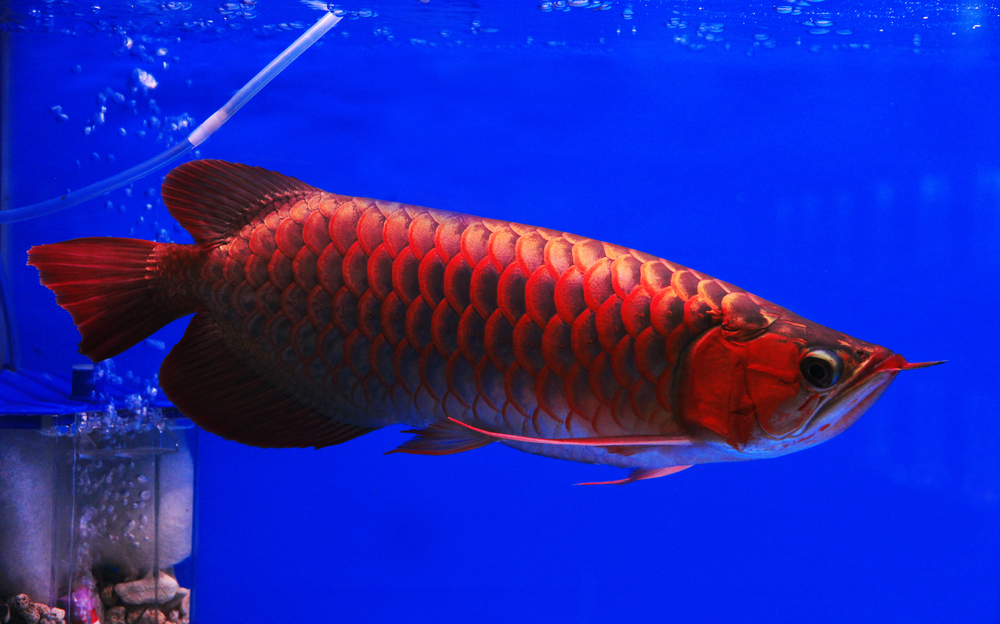
Learn More About Shark-Like Fish
If you are interested in keeping shark-like fish in your aquarium, several detailed guides can help you take the next step. Our guide to sharks for fish tanks explains which species are most commonly sold and provides proper care instructions.
If you are considering a bala shark, you can explore suitable companions in our article on bala shark tank mates. For aquarists who prefer the smaller Roseline Torpedo Shark, we have recommendations on top roseline shark tank mates to help you build a peaceful community tank. Feeding is just as important as tank setup, so our guide on what red tail sharks eat will keep this popular species healthy. Finally, if you are drawn to the colorful Rainbow Shark, our article on rainbow shark tank mates outlines the best choices for managing its territorial nature.
Share Your Shark Lookalike Stories
Have you kept any of these shark-like fish in your own aquarium? We’d love to hear about your experiences, challenges, and success stories. Share your thoughts in the comments below and join the conversation with other aquarists who appreciate these fascinating “false sharks.”

